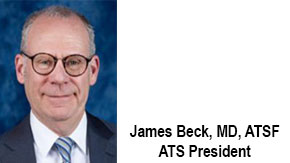How Do I Get Started?
One of the most common questions I’m asked by ATS members is how to become more involved with the society. ATS is a large, vibrant organization that spans its members’ interests in pulmonary, critical care, and sleep medicine. Because of our size, the way ATS is organized can be confusing, and this can add to uncertainty about where to start to become more involved. In this month’s column, I’d like to clarify the process for our members.
A good place to start to understand our structure is ATS 101, a document compiled by the Members in Transition and Training Committee and others. This pdf is a great guide to ATS governance and structure.
ATS Assemblies
Many new members of ATS begin their involvement with an assembly. ATS currently has 14 assemblies; some of these are focused on specific clinical and research areas (thoracic oncology, critical care) while others are focused on scientific approaches that span clinical topics (respiratory cell and molecular biology, respiratory structure and function). All of the assemblies maintain web sites that will help you understand their missions and goals. The leadership of the assemblies is elected, but there are plenty of opportunities to volunteer. For example, each assembly has a program committee that participates in framing each year’s International Conference. Many of the assemblies also have committees that focus on international members and junior members, and most have mentoring programs that pair junior professionals with more experienced assembly members.
ATS Sections
Not every clinical, research, and educational topic is a direct fit with one of the assemblies, and so ATS has three sections (Genetics and Genomics, Medical Education, and Terrorism and Inhalational Disasters).
ATS Committees
ATS has 27 committees, and the members of most committees are appointed by the ATS Executive Committee under the leadership of the President-Elect (for the 2020-2021 year, Juan Celedón, DrPH, MD, ATSF). The year of committee work begins and ends with the International Conference in May and the general term of committee service is three years. The Executive Committee collaborates with the committee chairs, vice-chairs, and staff to frame benchmarks for each year’s activities, and these benchmarks and committee rosters are available on the web site. Consideration of rosters and benchmarks begins in December and is finalized in April, so now is an excellent time to volunteer!
The “Get Involved” Portal
For the last several years, the ATS has offered a “Get Involved” portal on the web site. The portal provides an opportunity for any ATS member to express their interest in assemblies, sections, and committees. In addition to indicating interest, the portal requires a statement of interest and an uploaded CV, and also permits an optional nomination letter. We encourage the elected leadership of the assemblies and sections to consider nominations and self-nominations from the portal as they populate their assembly activities. In addition, the ATS Executive Committee works with the chairs, vice-chairs, and staff of the standing committees to populate their rosters. Members who volunteer in the portal are considered preferentially.
What Do I Do If I Volunteer But Don’t Get An Assembly, Section, or Committee Position?
If you’re not named to a position the first time you volunteer, don’t be discouraged. ATS is very fortunate that we have more volunteers than positions, so every member may not be appointed. Information from members who volunteer through the portal is carried forward, and often appointments happen in the following year. There is a home for everyone in ATS, and there’s a place for each member to thrive within our society!

